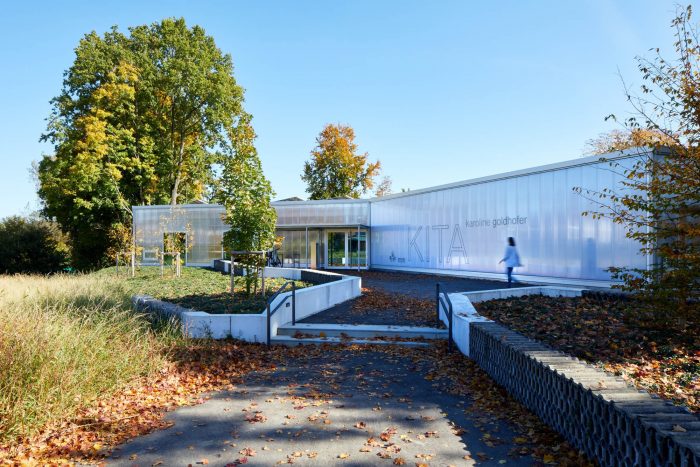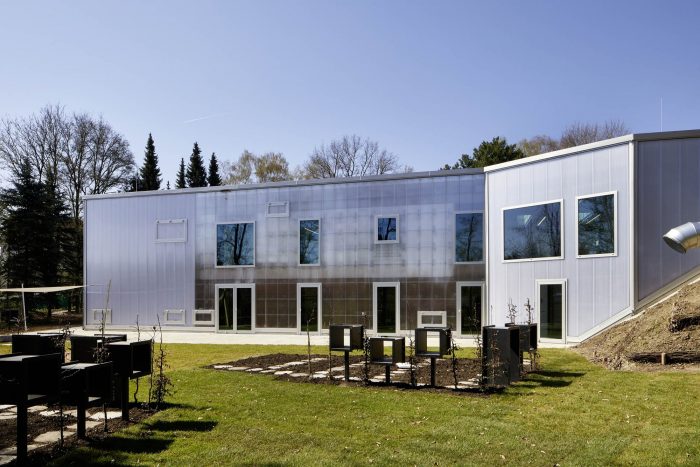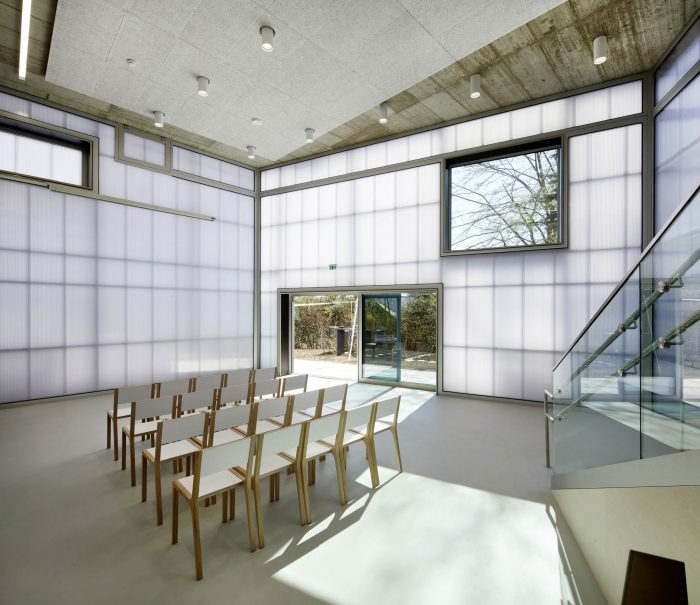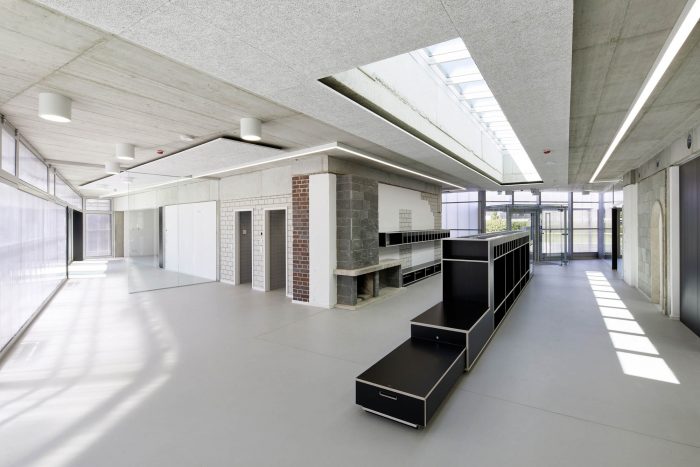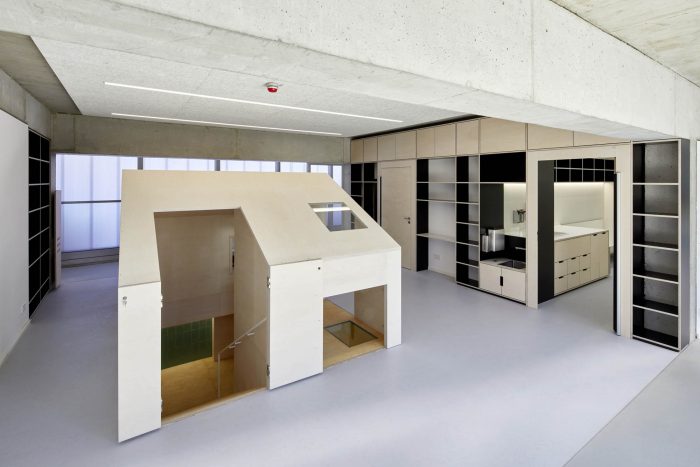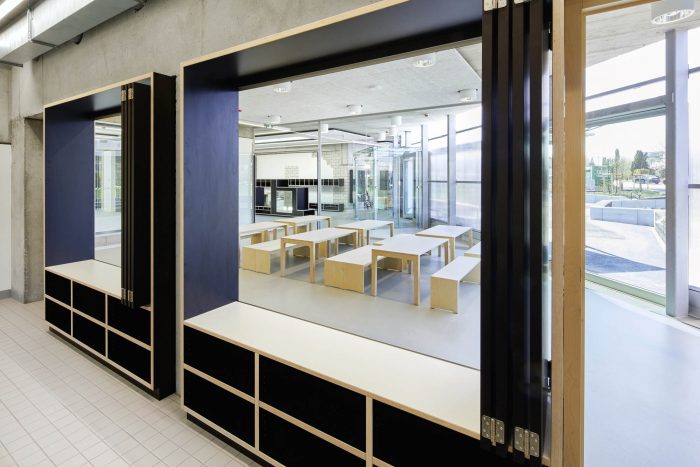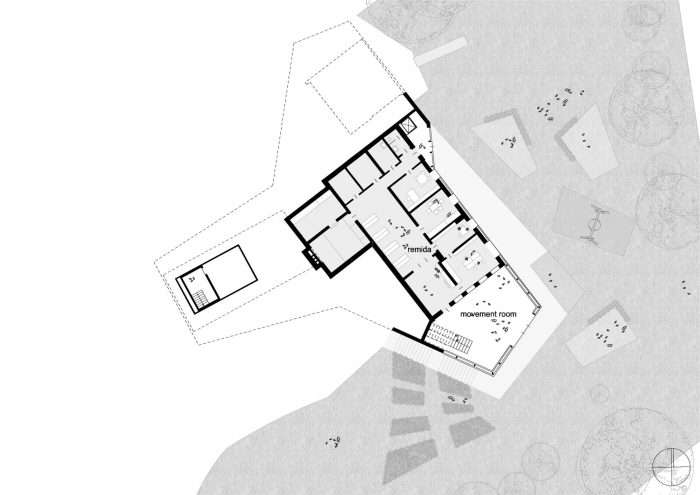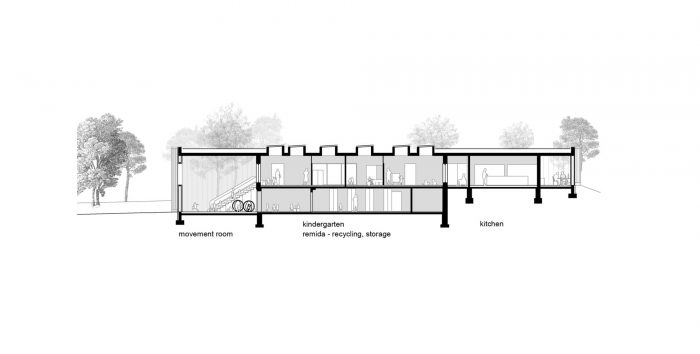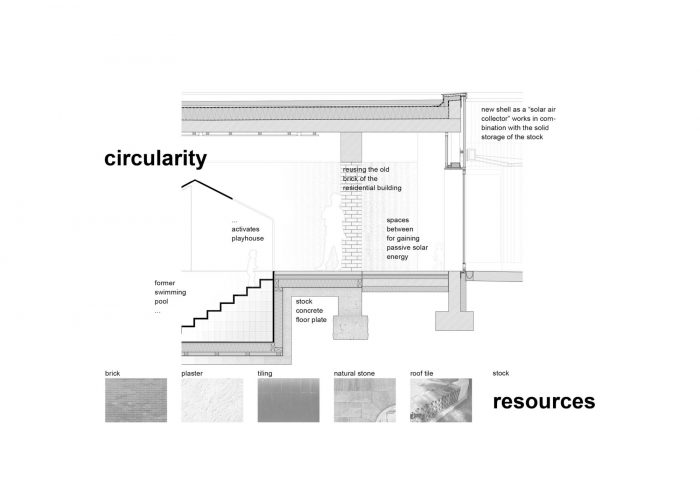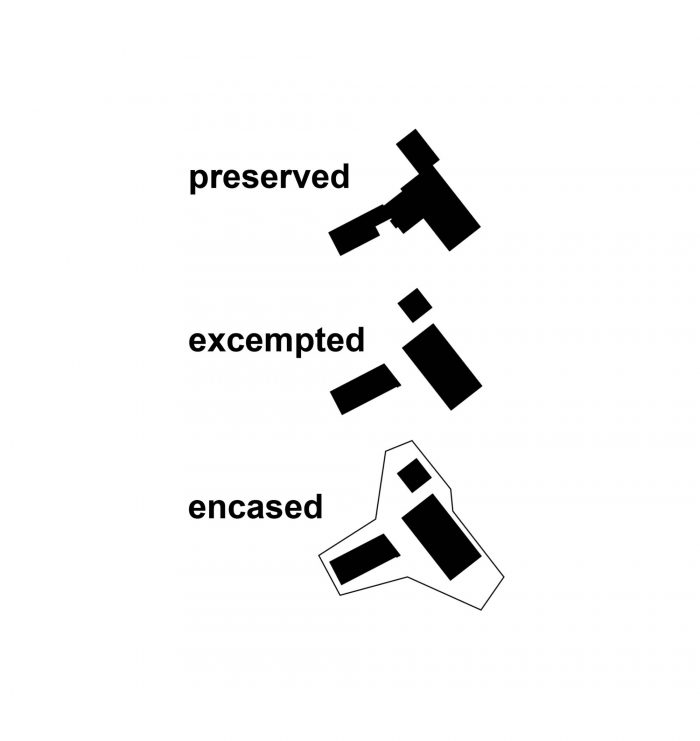日托中心的概念来自于瑞吉欧教学法,这是由非营利性的Alois Goldhofer基金会有意识地选择的。在这一教学法中,旧物的再利用和保护是至关重要的。另一个基本方面是利用现有建筑的优点而不是缺点。为此,老房子的存量被激活。
The concept for the daycare centre originates from the Reggio pedagogy applied in it, which was consciously chosen by the non-profit Alois Goldhofer Foundation. In this pedagogy reusing and taking care of the old is essential. Another elementary aspect is that the strengths of the existing building are used rather than its weaknesses. For this, the stock of the old house is activated.
因此,老房子被保留、豁免,并被包裹在一个新的、半透明的外壳之下。新旧之间的空间是托儿所的空间延伸和可持续能源概念的元素。新的外壳由可回收的聚碳酸酯制成,是光和能量的收集器。它允许现有的墙壁保持不保温,并作为一个历史层。
Therefore the old house was preserved, exempted, and encased under a new, translucent shell. The resulting spaces between old and new are space extensions for the daycare and elements of the sustainable energy concept. The new shell made of recyclable polycarbonate is a collector of light and energy. It allows the existing walls to remain uninsulated and as a historical layer.
在寒冷的季节,通过外墙获得的被动式太阳能用于建筑的热平衡。在夏季,存量的储存质量和雨水蓄水池支持房屋的自然冷却。因此,能源的自然生成和循环利用成为孩子们日常生活的一部分。因此,能源概念是空间、光照、存量和使用的相互作用。这使得在建筑和空间上节约和获得能源成为可能–替代传统的隔热材料。通过减少和重复使用建筑材料和 “灰色能源”,以及将二氧化碳排放量减少到5公斤/平方米a,2050年的气候目标已经实现。
In the cold seasons, the passive solar energy gained through the façade is used for the building’s heat balance. In summer the storage mass of the stock and a rainwater cistern support the natural cooling of the house. So the natural generation of energy and circularity become part of the children’s day-to-day life. The energy concept is thus an interplay of space, light, stock, and use. This makes it possible to save and gain energy architecturally and spatially – alternatively to conventional thermal insulations. By reducing and reusing building materials and “grey energy” as well as cutting CO2 to 5 kg/m2a the climate target of 2050 is already met now.
这个概念可以在日托中心的建筑中体会到。旧住宅的结构、材料和细节被原封不动地保留下来,成为新目的和新空间的可感知元素。现有的墙壁支撑着新的屋顶。旧的烟囱矗立在中央的聚会场所–露天广场上。前立面的熟料砖与新的半透明外壳一起包围了高活动室。以前居民游泳的游泳池,现在成了孩子们的藏身之处,可以通过一个木制的游戏室进入。
The concept can be experienced in the architecture of the daycare centre. Construction, materiality, and details of the old residential house are left as they are and become perceptible elements of the new purpose and space: The existing walls support the new roof. The old chimney stands in the central meeting place, the piazza. The clinker bricks of the former façade enclose the high movement room together with the new translucent shell. The previous swimming pool, where the residents used to swim, is now a hiding place for the children and can be entered via a wooden playhouse.
固定装置的规模也表明了这个建筑的对象,即儿童。家具不仅要实现单纯的功能,如储存物品或提供座位,还要为孩子们提供行动的平台。其他的材料都是生的或未经处理的,以达到重复使用的目的,并让孩子们看到建造的过程。
The scale of the fixtures also indicates for whom the building is intended, namely children. The furniture is not only supposed to fulfill pure functions such as storing objects or providing seating, but also offers platforms for the children to act. Additional materials are used raw or untreated for their reusability and to make the building process visible for the kids.
景观建筑中也延续了重复利用和循环性。在这里,孩子们可以在创始人宽敞的前花园中的老树之间玩耍,并尝试使用建立的材料。
Reuse and circularity are also continued in the landscape architecture. Here the children can play and experiment with founded materials between the old trees in the founders’ spacious former garden.
日托中心的建筑正在寻找欧洲 “绿色政策 “任务的答案,即以气候中立和生态方式改造我们的大陆。我们如何利用建筑存量并节约资源?我们如何避免二氧化碳,获得空间?如何将气候保护体验为空间的丰富?
The architecture of the daycare centre is looking for answers to the tasks of the European “Green Deal” to transform our continent climate-neutrally and ecologically: How do we use building stock and save resources? How do we avoid CO2 and gain space? How can climate protection be experienced as spatial enrichment?
建筑师:Heilergeiger architekten und stadtplaner BDA
面积:1123平方米
年份:2019年
摄影:Nicolas Felder
制造商:Rodeca, Ceramica Vogue, FSB, HEWI, Hella, Heradesign, Kemmlit, Planlicht, Schörghuber, Wicona, Arnold Glass, Axitec Energy, Böcker, Forbo, Glas Trösch, Lenneper Leuchten, held Sportboden, kebu, sirch holzverarbeitung
作者:Jörg Heiler, Peter Geiger
合作者:Gorazd Cater, Miriam Hirn, Claudia Kießig, Tina Kolb, Fabiana Pizzoli, Theresa Schuster
3D热力学模拟:Ifes Institut für angewandte
结构工程:IHW Beratende Ingenieure
景观设计师:Latz + Partner
环境工程师:Güttinger Ingenieure
电气:Kettner & Baur GmbH
灯具供应商:Generation Licht
声学工程师:BL-Consult Piening GmbH
消防系统:Anwander GmbH & Co. KG
城市:Memmingen
国家:德国
Architects: heilergeiger architekten und stadtplaner BDA
Area: 1123 m²
Year: 2019
Photographs: Nicolas Felder
Manufacturers: Rodeca, Ceramica Vogue, FSB, HEWI, Hella, Heradesign, Kemmlit, Planlicht, Schörghuber, Wicona, Arnold Glass, Axitec Energy, Böcker, Forbo, Glas Trösch, Lenneper Leuchten, held Sportboden, kebu, sirch holzverarbeitung
Authors:Jörg Heiler, Peter Geiger
Collaborators:Gorazd Cater, Miriam Hirn, Claudia Kießig, Tina Kolb, Fabiana Pizzoli, Theresa Schuster
3d Thermodynamically Simulation:Ifes Institut für angewandte Energiesimulation
Estructural Engineering:IHW Beratende Ingenieure
Landscape Architects:Latz + Partner
Environmental Engineerig:Güttinger Ingenieure
Electrical:Kettner & Baur GmbH
Lighting Consutlant:Generation Licht
Acoustical Engineers:BL-Consult Piening GmbH
Fire Protection Systems:Anwander GmbH & Co. KG
City:Memmingen
Country:Germany


